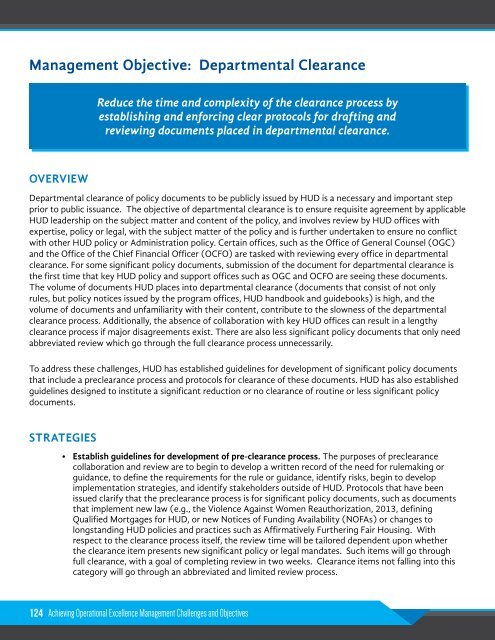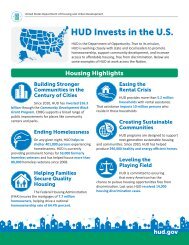Annual Performance Plan 508
Annual Performance Plan 508
Annual Performance Plan 508
Create successful ePaper yourself
Turn your PDF publications into a flip-book with our unique Google optimized e-Paper software.
Management Objective: Departmental Clearance<br />
Reduce the time and complexity of the clearance process by<br />
establishing and enforcing clear protocols for drafting and<br />
reviewing documents placed in departmental clearance.<br />
OVERVIEW<br />
Departmental clearance of policy documents to be publicly issued by HUD is a necessary and important step<br />
prior to public issuance. The objective of departmental clearance is to ensure requisite agreement by applicable<br />
HUD leadership on the subject matter and content of the policy, and involves review by HUD offices with<br />
expertise, policy or legal, with the subject matter of the policy and is further undertaken to ensure no conflict<br />
with other HUD policy or Administration policy. Certain offices, such as the Office of General Counsel (OGC)<br />
and the Office of the Chief Financial Officer (OCFO) are tasked with reviewing every office in departmental<br />
clearance. For some significant policy documents, submission of the document for departmental clearance is<br />
the first time that key HUD policy and support offices such as OGC and OCFO are seeing these documents.<br />
The volume of documents HUD places into departmental clearance (documents that consist of not only<br />
rules, but policy notices issued by the program offices, HUD handbook and guidebooks) is high, and the<br />
volume of documents and unfamiliarity with their content, contribute to the slowness of the departmental<br />
clearance process. Additionally, the absence of collaboration with key HUD offices can result in a lengthy<br />
clearance process if major disagreements exist. There are also less significant policy documents that only need<br />
abbreviated review which go through the full clearance process unnecessarily.<br />
To address these challenges, HUD has established guidelines for development of significant policy documents<br />
that include a preclearance process and protocols for clearance of these documents. HUD has also established<br />
guidelines designed to institute a significant reduction or no clearance of routine or less significant policy<br />
documents.<br />
STRATEGIES<br />
• Establish guidelines for development of pre-clearance process. The purposes of preclearance<br />
collaboration and review are to begin to develop a written record of the need for rulemaking or<br />
guidance, to define the requirements for the rule or guidance, identify risks, begin to develop<br />
implementation strategies, and identify stakeholders outside of HUD. Protocols that have been<br />
issued clarify that the preclearance process is for significant policy documents, such as documents<br />
that implement new law (e.g., the Violence Against Women Reauthorization, 2013, defining<br />
Qualified Mortgages for HUD, or new Notices of Funding Availability (NOFAs) or changes to<br />
longstanding HUD policies and practices such as Affirmatively Furthering Fair Housing. With<br />
respect to the clearance process itself, the review time will be tailored dependent upon whether<br />
the clearance item presents new significant policy or legal mandates. Such items will go through<br />
full clearance, with a goal of completing review in two weeks. Clearance items not falling into this<br />
category will go through an abbreviated and limited review process.<br />
124 Achieving Operational Excellence Management Challenges and Objectives



